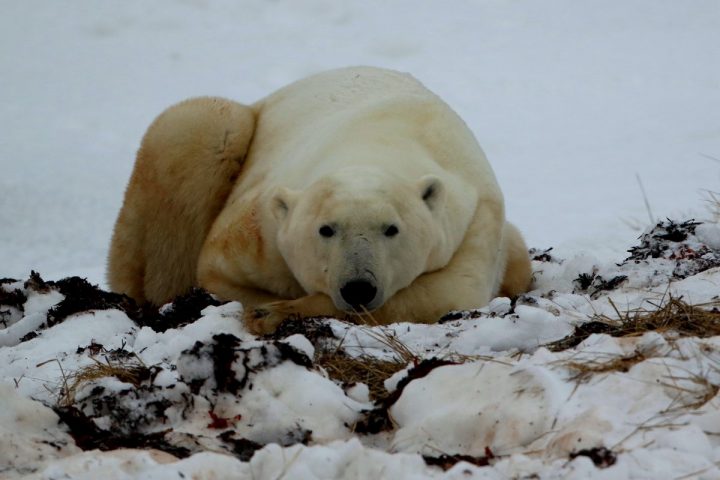
CHURCHILL, Manitoba — What do polar bears have to do with the future of coastal North Carolina? Nothing and everything. At least that is my conclusion after having the opportunity to learn about and witness these magnificent creatures in the wind-swept wilds of Manitoba, Canada. This iconic beast of the permafrost-covered tundra has become the poster child representing global warming and thus, climate change and sea-level rise.
My wife, Bright Walker, has long been fascinated with polar bears and made arrangements for us to meet these arctic beasts. I’ve also wanted to see polar bears in their wild native habitat. Why, I’m not sure, but I think it has to do with their ability to exist in the extreme harsh conditions of the arctic and subarctic. They live in such remote locations that they are almost mythical, like a unicorn. Put the words polar and bear together and that’s an animal I want to see.
Supporter Spotlight
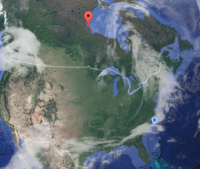
Our desire to see polar bears became a reality in November as we looked out the window of the plane on its approach to Churchill. Churchill, the “Polar Bear Capital of the World,” is at the mouth of the Churchill River where it empties into Hudson Bay. It is here, during mid-October through mid-November, where the white bears migrate and congregate along the shore waiting for the bay to freeze. By late November, the bay is usually frozen enough for the bears to venture out on the packed ice in search of their favorite prey, ringed and bearded seals.
Stepping off of the plane, I expected to be chilled by the numbing, subfreezing cold that is typical for Churchill this time of year. Instead, it was a relatively balmy 40 degrees, close to 30 degrees warmer than normal. In a town where the bears outnumber the people, I was expecting to see bears meandering everywhere, each with a bottle of Coke in its paw. To avoid bear-human conflicts, a Polar Bear Alert Team, through Manitoba Conservation, maintains a control zone around the town and conditions any curious bear, through the use of startling tactics, to stay out of town. Some of the more stubborn bears are captured in live traps and taken to the Polar Bear Holding Facility, locally referred to as “polar bear jail.” When the bay finally freezes, the bears are released out on the ice, well away from town.
A bus took us and the group we were traveling with to what was called the “tundra rover launch.” Here, a fleet of these massive vehicles waited to transport polar bear-loving tourists. The rover we stepped into was brand new, a tour bus hopped up on steroids with a bathroom, hot beverages and plush seats. A massive windshield and long rows of windows provided a great view for all passengers. The toasty rover rolled away and headed to a tundra lodge, where we would spend the next few nights. The strategically placed lodge looks like an overgrown train with five cars where the group is housed and fed in a prime sea bear viewing area.
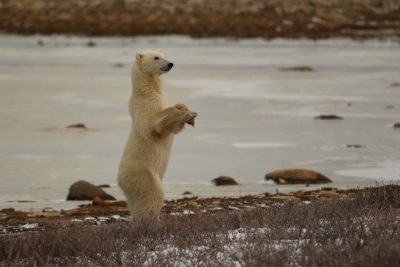
Arriving at the lodge as darkness fell, a lone polar bear slowly rambled over to the lodge with its nose in the air. Viewing from the safety of the lodge deck, someone in the group asked, “Is it smelling the cooking from the kitchen?” Our guide replied, “No, it is smelling us.” Polar bears may appear cute and cuddly, but they are all business when it comes to looking for food. Though attacks on humans are rare, its best not to tempt the apex predator of the Arctic when it is has been fasting for more than three months.
The next morning, the rover headed out on a viewing safari through a maze of roads along the shores of the bay that are part of the Churchill Wilderness Management Area. The rover rolled past outcroppings of large gray rock jutting up through the ground like worn-smooth teeth. Rock that shows the scars and polish from the weight of a 9,000-foot glacier that once dominated the land. The landscape was pockmarked with numerous small, shallow, frozen water holes called kettle ponds that were formed by huge chunks of ice that calved off of the retreating glacier. Here and there, 500-year-old white spruce trees stood stunted by years of cold, their diminutive height betraying their ancient age.
Supporter Spotlight
Out on the tundra, with the iceless waters of the Hudson Bay within sight, our guide instructed us to look for the color of a potato chip among the shrub line of the kettle ponds. Here, the bears will be resting in the lee of the willows protected from the wind. Bright was a keen spotter, finding bears that the rest of us would have overlooked. Throughout the morning, we came across individual bears biding their time, curled up in soft beads of kelp that were deposited along the high-tide line of the bay. They were so acclimated to the rovers that they only reluctantly acknowledged our presence and then went back to sleep.
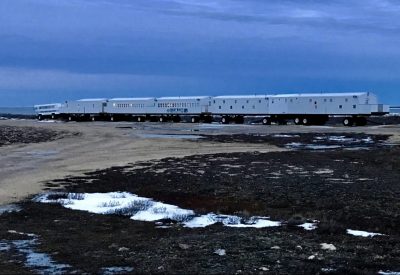
Female bears with cubs were more alert, vigilant and moving around to avoid complacency. Under the desperation of hunger, if the opportunity presents itself, an adult male will prey on the cubs. We witnessed this drama unfold as a female and two cubs were snuggled together among some willows. As we oohed and aahed at the cute sight, the female suddenly lifted her head high as she caught the scent of an unseen male. She quickly guided the cubs out across a large, frozen kettle pond as a bruiser of a male exited the willow thicket and made his way onto the pond. The female and cubs then exploded into an all-out escape run as the talking in the tundra rover fell silent. Our guide quietly and calmly reminded the group about the harshness of nature. I could then hear soft chants of “run, run, run” to encourage the cubs. The male gave a halfhearted chase and quickly gave up as it began to overheat in the moderated temperatures.
To protect the permafrost and not disrupt the bear’s behavior, the rovers are restricted to road travel only. Thus, sometimes the viewing was from quite a distance, but frequently we were treated to up close viewing that made you really appreciate these specialized animals.
Perfectly Adapted
Physically, the sea bear is perfectly adapted to their cold, wet and icy home. Their fur color provides perfect camouflage for capturing prey. A thick layer of fat and two coats of waterproof fur maintain a steady body temperature even when temperatures dip to 30 below zero. Their tiny ears and a small tail significantly reduce the surface area where heat radiates from the body. The huge, island-sized paws have adaptations for many purposes. Sharp grappling hook-like claws make capturing prey easy. Their feet are wide and massive to help distribute the weight of their more than 1,000-pound bodies, reducing the likelihood of falling through the ice. The bottoms of their feet are covered with tiny bumps called papillae that act like snow chains on a tire for traction. A bit of webbing between the toes of their front paws propels them through the water at 6 mph, leaving any Olympic swimmer in their wake. Classified as a marine mammal, their hollow hair provides buoyancy when swimming long distances between ice flows.
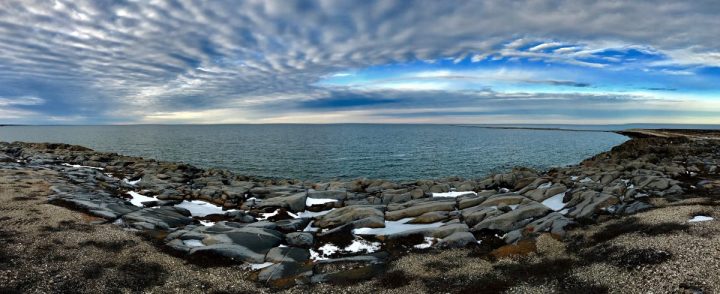
Their bodies and lifestyle are so specialized that they are vulnerable to the consequences of global warming and the loss of life-giving sea ice. Sea ice now forms later each year and melts earlier, resulting in fewer weeks for the polar bears to hunt seals before the ice melts. Winter is when the food is abundant, thus polar bears don’t hibernate. After the melt when the bears are back on land, food is limited and they basically fast and wander in what is called a “walking hibernation.”
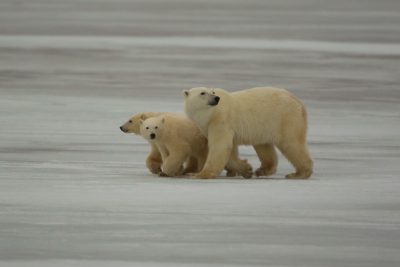
Overwhelmingly, the scientific community agrees that carbon dioxide and methane emissions along with deforestation are the major causes that prevent heat from escaping the atmosphere, resulting in global warming. In the Arctic, sea ice and glaciers help to steady global temperatures by keeping the polar areas cool. The arctic ice and snow reflect sunlight and act as a protective barrier, preventing the warming of land and waters under it. However, because of warming polar temperatures, there is now less surface area of sea ice and glaciers and fewer days of seasonal sea ice. The amount of Arctic sea ice in 2016 was at a record low with more land and water exposed to absorb the heat rather than reflect it.
So, what do polar bears have in common with coastal North Carolina? As they lose their habitat, so will we. The loss of sea ice magnifies the warming of our oceans causing thermal expansion, resulting in sea-level rise. This thermal expansion, along with the melting of land-based glaciers, raises the sea level. Many scientific researchers say that even if we immediately start taking serious measures to combat global warming, the tidal wave we have launched cannot be called back, it will eventually reach the shore. It is already evident and will continue in the form of erosion, flooding and saltwater intrusion. Additionally, ocean acidification from carbon emissions may soon have a corrosive effect on developing shellfish shells and climate change could bring us more severe hurricanes.
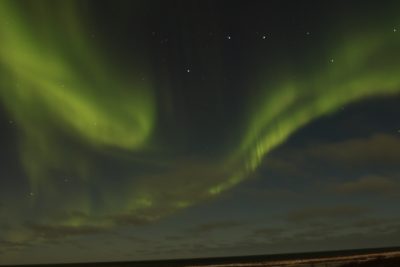
Under a cloudy evening sky, I stood out on the deck of the tundra lodge as one of the bears silently walked by with the swagger of the “Lord of the Arctic.” The joy and excitement of seeing polar bears was personal and deeply emotional to many of the visitors. Our guide mentioned at the end of one of our trips across the tundra, “I saw tears today; it has been a good day.”
The layer of clouds evaporated and green curtains from the heavens began to spread across the sky. Alive and vibrant, the northern lights shimmered, undulated and cascaded in the atmosphere above the lodge. It danced like a ballet without the dancers; it was a song without sound and a poem without words. As the neon lights above me began to fade, I began to think about the polar bears and whether they too will fade into a memory and become as mythical as a unicorn.







